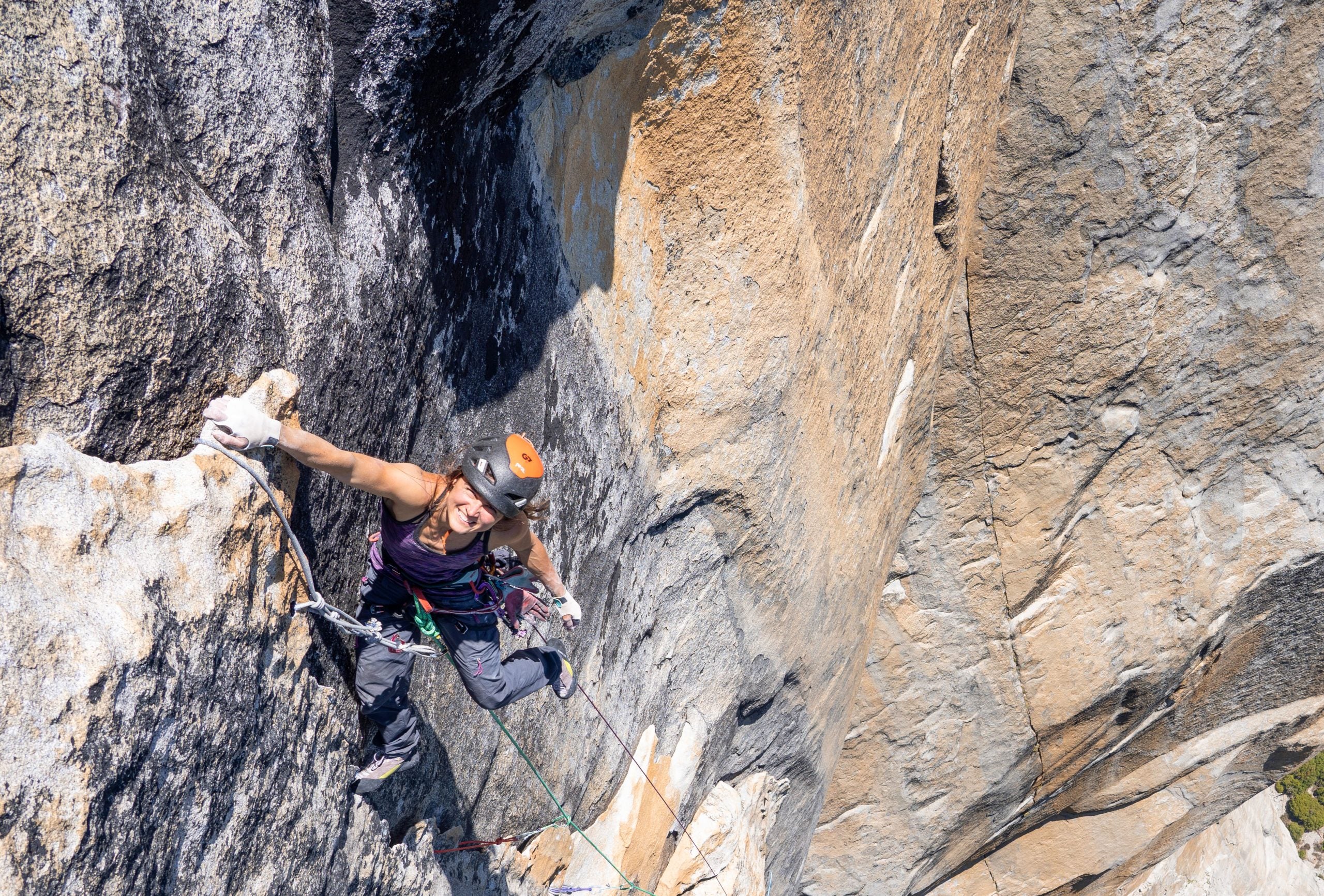Bronwyn Hodgins Ticks Third Female Ascent of Golden Gate

(Photo: Nick Smith)
As of May 13, Bronwyn Hodgins from Squamish, B.C., made the third female ascent of Golden Gate (5.13a, 34 pitches) on El Cap’s Southwest Buttress—and found a section of downclimbing, at the very first crux, to be the toughest spot.
“I’m 5 foot 5, and the downclimb was probably the hardest move on the whole route,” she says of pitch 19. While she was stepping down through the insecure sequence, “I was above the crimp and could barely get my fingertips on the hold below. I couldn’t get my wrist low enough to crimp, so it felt like I was standing on my hand….like I was going to squash my fingers.” The ascent was still a fight to the very end.

The ascent marks Hodgins’ seventh time up El Cap and second free climb of the formation. Her additional ascents of El Cap include the Nose, Freerider (done free), Salathé Wall, and El Corazon. Also in Yosemite, she’s linked the long classic 5.11 free climbs the North Face of the Rostrum and Astroman on Washington Column. She freed Moonlight Buttress in Zion (1,200 feet, 5.12c) in 2015 after only climbing for two and a half years. She has also established a new free route on Mt. Asgard in Baffin Island, in 2019.
Climbing caught up with Hodgins in northern Washington, where she was nearing the Canadian border to return home before her travel visa expired at midnight. Golden Gate, done over eight days, was the prize of her six-month visit to the U.S.
To prepare for El Cap, Hodgins, a professional climber and a river and rock-climbing guide, sport climbed over the winter in Saint George, Utah, where she ticked 5.13s within a few attempts. Setting the goal of sending 5.13 fast improved her sequence-finding ability, power, and endurance. She coupled that skill with strategic planning for the big wall, where she made sure to rest, eat and hydrate throughout each day.
“That attitude was on my mind the whole way. My goal was to be as efficient as possible and be able to perform day after day.”
Freed by Alex and Thomas Huber in 2000, Golden Gate follows the Salathé Wall/Freerider for 18 pitches, to one pitch past El Cap Spire, where it cuts right to the Heart Route (FA: 1970, Scott Davis and Chuck Kroger), crossing in and out of that route to reach the summit.
The first female ascent of Golden Gate was by Hazel Findley in 2011. Emily Harrington freed it in 2015 and returned in 2020 to free the route in a day.

Hodgins partnered with Danford Jooste to swap leads. Golden Gate has four pitches of 5.13, one of 5.12, plus runout 5.10 and 5.11 face climbing, and cracks of all sizes, including brutal 5.10+ offwidths. The crux breakdown contains a balancy-reachy step-down sequence (5.13a) on pitch 19, the bouldery Move sequence (5.13a) on pitch 24, the Golden Desert crack (5.13a) on pitch 28, and the A5 Traverse (5.13a) on pitch 29.
Before her redpoint ascent, Hodgins spent weeks rappelling into the route to work out sequences and stash supplies.
During the first third of the route, she and Jooste chose to skip the downclimb 5.11 into the Monster Offwidth at pitch 14, so they approached the Monster 150 feet lower than most parties and did two back-to-back pitches of seven-inch crack climbing.
Three pitches higher, on pitch 19, came the route’s first crux, the delicate step-down, at 5.13a. Because the downclimb crux is positioned in the middle of the 3,000-foot wall, Hodgins had only briefly been able to preview this section. During her ground-up ascent, she required two days to redpoint the downclimb.
After succeeding there, Hodgins faced the Move pitch on pitch 24, using a double Gaston and high step to reach for a pocket. “This is a really bouldery, shouldery lock-off move,” she says. During her pre-inspection, she had linked this crux six times: “I knew I could do it. But it takes place above 5.12 and it would be day five of a big wall. I knew it would be a fight up there.”
She nabbed the Move pitch in just two attempts. “She did the Move first go but slipped higher on the pitch,” her partner Jooste told Climbing from Yosemite Valley. “It was impressive to see her send it second go. It was super inspiring climbing with her and was an awesome time up there for all eight days.”
Jooste, from South Africa but currently living in his car on the road, says he plans to return to Golden Gate next season for his own redpoint ascent.
The next hard section, the Golden Desert pitch (pitch number 28), is “incredible,” Hodgins says. “It’s this long, beautiful endurance layback pitch that seems to go on forever.” She sent it on her first attempt.

After the Golden Desert came the A5 Traverse, the route’s final crux—where she made it within an arm’s length of the anchor before falling. She sent the pitch second go. After dispensing one last short section of 5.12a, Hodgins just had to hold on and keep her composure through thin flakes and a final tricky sequence.
“The end of this route is extremely sustained 5.11 layback flakes on this steep wall,” she says. “You’re on day eight, and you are trying hard but not hard enough that you’ll fall. And you’re overlooking the whole route below you. The last move is this 5.11b stem box boulder problem, which feels way harder, and the top is right there! I had to try really hard there.”